Archive : Article / Volume 2, Issue 1
Case Report | DOI: https://doi.org/10.58489/2836-2276/011
Development of a Domestic Water Medium Rice De-Stoning Machine
1Department of Mechanical Engineering, School of Engineering and Engineering Technology, Federal University of Technology, Akure, Nigeria
2Engineering Materials Development Institute, Akure, Ondo State, Nigeria
Correspondng Author: S. B Danjuma*
Citation: S. B Danjuma, P.K Oke, (2023). Development of a Domestic Water Medium Rice De-Stoning Machine. Journal of Food and Nutrition. 2(1). DOI: 10.58489/2836-2276/011
Copyright: © 2023 S. B Danjuma, this is an open-access article distributed under the Creative Commons Attribution License, which permits unrestricted use, distribution, and reproduction in any medium, provided the original work is properly cited.
Received Date: 2023-05-29, Received Date: 2023-05-29, Published Date: 2023-07-12
Abstract Keywords: rice, domestic rice-destoning, water medium
Abstract
It has become critical to build a de-stoning machine that can be used in our homes whenever we need it. As a result, the goal of this research was to develop and build a wet-method household rice destoning equipment. The design was built utilizing locally accessible materials and was based on the notion of material separation using water as a medium of separation. A reservoir, hopper, de-stoning chamber, washing chamber, impeller, water filter, and brush drum make up the machine. The produced machine was powered by a 1 horsepower variable electric motor that communicated the rotating motion of the driving pulley to the driven pulley, which was supported by bearings, through a V-belt. The machine was built and tested, and it was discovered that 2kg/10minutes and 20.04kg/hour of processed rice were destoned at a de-stoning speed of 400rpm, which is the optimal speed for maximum speed separation. The destoning machine's effectiveness in terms of stone removal is approximately approaching 100 percent free of impurities, making it ideal for residential usage. This discovery elucidates the potential to deal with the challenges of stone removal from locally produced rice using hand and manual method, which are inefficient, time and energy wastage, it acts as a rice processing industry innovation.
Introduction
Rice, (Oryza sativa) is a monocot crop, is generally farmed for a year but may persist as a perennial crop in tropical places. Rice is among the three major crops in the world, and it contributed greatly to satisfy the food needs in the world. The role of rice crop is necessary in the present and future extensive food security [6]. Rice is a staple meal for more than half of the world's population of 100 million people and is highly competitive in international trade. It is very nutritious and has high calorie contents, accounting for more than one-fifth of all calories ingested by people globally. The rice field in Nigeria is one of the major notable agricultural development more than ten years [28]. Today, rice is sold on the streets of all cities and villages in the country and for many families; it is a daily item on the menu.
Global rice production in 2021/22 study and analyze has a record of 513.0 million tons down 1.0 million tons, but 4.2 million tons larger than a year earlier. On an annual basis, India, China, Pakistan, Australia, Bangladesh, Cote d’Ivoire, Nigeria, Paraguay, South Korea, Senegal, and Thailand account for the bulk of the projected global production increase in 2021/22, with Australia, Bangladesh, China, India, and Thailand showing the largest year-to-year increases. China and India are the two largest rice producing countries in the world with production rate of 149 million tons and 129 million tons count for more than half of annual global rice production. [19].
In Africa, rice producing has accrue from 3.14 million tons, to 14.60 million tons per year, while rice demand is estimated at about 24.3 million tons per year [11] and about 9.7 million metric tons of rice is imported into Africa yearly.
In Nigeria rice has demand per capita of 32kg indicating 4.7% increase in the past ten years making the total demand to be 6.4 million tons in 2017 as against 3.7 million tons yield per year [7].
Rice has two varieties named (Oryza sativa) and (Oryza glaberrimaare) for which oryza sativa is grown all over the world while oryza glaberrimaare is grown partially in western part of Africa [31].
Rice is very essential in Nigeria, establish on the many ways it can be used. The capacity to grow more rice has help in growth of many communities, while its scarcity has led to increase of famine, death and political unreliability in many countries including Nigeria [25,26]. The acceptance of rice as food has witness an upsurge lately by becoming a major crop in many countries in America and Africa [26].
Rice is use for different varieties in the northern part in Nigeria which include; ‘Masa’, ‘Kunun shinkafa’, and ‘Tuwon shinkafa’ while the most common form of food prepared with rice all over the country include parboiled rice eaten with stew, popped and puffed rice, rice flakes, canned rice and fermented produce. [25]. Rice husk is used for producing paper and as a source of fuel. Rice bran is used as animals feed, Rice bran oil is used in soap industry and rice bran wax, a byproduct of rice bran oil is used in industries [17].
However, stones, sand particles, dirt, chaffs, and other contaminants have been discovered in locally produced rice in Nigeria, contributing to its low quality and poor market appeal. One of the reasons limiting local rice's demand and potential for export to produce foreign cash for the country is its poor quality. These foreign elements or contaminants are frequently introduced into rice during harvesting, threshing, handling, packing, and other processes. According to Usman (1999), the harvesting and post-harvesting practices of local Nigerian rice increase the rate of impurities. As a result, cleaning must be done as a pre-processing procedure to remove unwanted materials.
De-stoning is the process of removing stones or contamination from various crops of different sizes and colors. It is a post harvesting process for the value addition of harvested crops. Mud usually is attached to the stem of rice when uprooted from the soil and thereafter, it dries up to become sand and stones which can only be removed by cleaning. Also, after parboiling, drying is usually carried out under the sun on bare floor, platforms or slabs which could also result in stones and other dry impurities being introduced into the rice. Hence, cleaning, as a preliminary operation, must be carried out to remove the unwanted materials or impurities from rice to increase the quality of locally produced rice and make it more attractive to the consumers [20]. In order to completely remove all the stones/sand and impurities from the seeds the use of de-stoners is of great significance.
These limitations necessitate need for appropriate technologies for cleaning locally produced rice. This study, therefore, developed a domestic rice de-stoner using water with a view to make better quality, increase productivity, and to reduce the drudgery involved in rice cleaning.
Previous Studies
Preceding the invention of rice de-stoning machine, farmers make use of local method to remove impurities and stones from rice. The local method includes removal of stone using hand, sieving, winnowing, removal of stones using water in a bowl or calabash, but this is time exhausting, boring and impurities such as stones, sticks, chaff and sand are not totally removed. The need to improve the quality of rice for domestic consumption at reduced time and stress has necessitated the invention of a domestic rice de-stoning machine. In order to fully remove all the stones/sands and impurities from the seeds the use of de-stoners is extremely important [17]. Many researchers have designed and fabricated machines for the separation of stones/sand and other impurities from processed rice to meet the public demand for a clean product. [12,2,27,24]. This has impart many new innovations and technique of removing impurities from rice. [2], for example, developed and fabricated a rice de-stoning machine using a vibrating sieve and achieved a high destoning efficiency. [24], developed a cereal cleaner capable mostly for use in processed rice cleaning contaminants. Henderson (Henderson) developed a gravity-based and floating separator. Yet, using a separator in removing impurities from the rice is stressful and sufficient drying will be required to avoid the possibility of fungi or mold growth on the rice during storage [9]. [23] work on development of a motorized rice de-stoning machine. The technical definition of the design machine, nevertheless, are very complex and hard to reveal [21,27,1,5].
A lot of rice de-stoning machine (imported) are very costly. The ones being developed in Nigeria uses dried method and non-of these machines that have not recorded breakage, tray loses and stones that are relatively of the size of rice were not separated. The wet method uses water as a medium of separation and as a result of bulk density difference of stone/sand (irregular shape) and rice, the stone density is 1.33g/cm3 while 0.51g/cm3 for rice. Large quantity of rice float with the water while the stones settled down at the bottom of the container and be collected at the coarse surface. The water pass through a screen and be re-circulated to the reservoir to avoid water wastage. There is no breakage of rice and tray losses due to vibration from the machine. Stone that are relatively the same size of the rice were separated and the rice is properly clean. This provides a good efficiency in solving the traditional method of removing stone from our locally produced rice in our domestic households.
The structure and arrangement of the paper. The paper introduced a brief overview of the technology of de-stoning and rice farming. Thereafter, the methodology examines the process of identifying the design concepts and parameters of the rice de-stoning machine. The rice de-stoning machine using wet medium was picked with detailed design parameters discussed. The machine performance was evaluated to ascertain real life application. This study will encourage rice farming globally especially in developing countries by virtue of the affordability and efficiency of this machine. Locally made rice free of stones and nutritional will be common in place.
Methodology
Design Considerations
The machine was developed from first principle approach. A review of existing methods and principle of de-stoning was carried out. The design study is completely accomplish to find the important design measurable factors and material strength for thought in choosing of the various rice de-stoner parts for the machine to carry out efficiently and to stop non-performance of the machine during the time for which is expected to operate. Thereafter, a final concept was picked from the lot and the wet method was adopted. The machine was designed and simulated using computer aided machine tool such as Autodesk Inventor for students. The analysis discovered that toughness, ductility, strength, hardness, and malleability were some of the mechanical properties that affected the materials utilized in this project. Surface polish, density, interaction with the environment, fabrication cost, maintenance cost, and material availability, as well as manufacturing simplicity and material safety, were all considered. The final machine was manufactured on a shop floor using conventional machines such as Lathe, grinder, drilling machine and CNC Lathe. The assembling and finishing were done using electrical welding machine. The finishing and quality assurance was performed. The manufactured machine was evaluated to ascertain the performance and the data discussed.
Machine Design Calculation
Table 1: Parameters of other functioning parts of the Machine
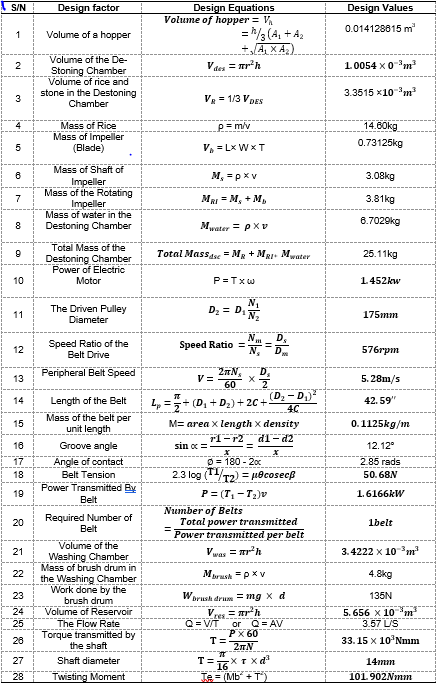
Hopper Capacity
The volume of the hopper is a function of the dimension of the rice which also depends on the volume of the rice to be fed into the de-stoning chamber per batch.
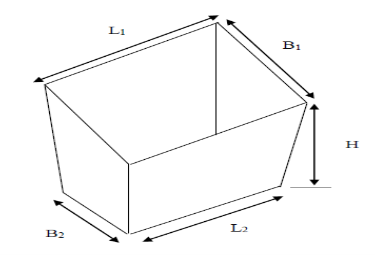
Volume of hopper according to Masser and Jensen (1991); and Eric et al., (1982) is;

Where; Vh = Volume of hopper, A1 = Hopper inlet area, L1 = Length of outlet point, B1 = Breadth of outlet point, A2 = Hopper outlet area, L2 = Length of inlet point; B2 = Breadth of inlet point, H = vertical height of hopper
A1 = 0.0224 m2, A2 = 0.00805 m2, H = 0.07 m

Vh = 0.014128615 m3
= 0.0141 m3
The calculated capacity of 0.0141 m3 will allow the operator to feed the machine as many times as possible. This prevents overloading or any form of clogging when the machine is in operation.
Capacity of the De-Stoning Unit
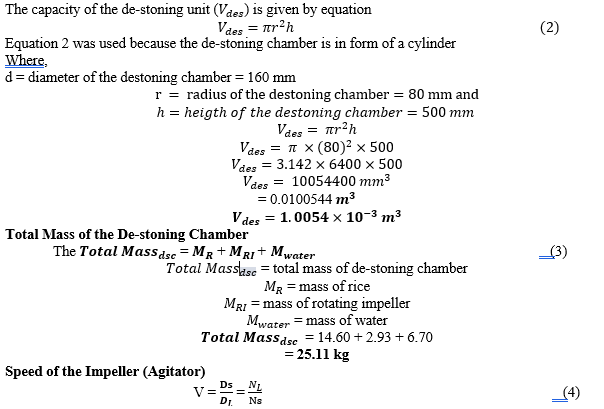
Where;
V = speed of the impeller (agitator)
DS = driving pulley diameter
DL= driven pulley diameter
Ns = speed of driving pulley in revolution per minute
NL = speed of driven pulley in revolution per minute
NS = 1440 rpm, DS = 70 mm and DL = 175 mm
NL= (70 ×1440)/175 = 100800/175 = 576 rev/min
Shaft Design
Loads acting on the shafts are three impeller blade, brush drum and pulley. Dimensions of components on the shafts was based on the shape and size of the impeller.
a)Impeller blade
The number of the blade is a function of the maximum volume of the rice in the destoning chamber during operation. Length of blade is chosen based on the distance between the wall of the destoning chamber and the clearance.
Determination of capacity of the impeller (V)
Total capacity of the impeller blade = 0.0000325m3
Mass of the rotating impeller = 3.81kg
b)Beaters (blades)
The function of the beater is to complete the destoning processes by causing the turbulent of the rice and water.
Determination of weight of beaters (Wb)
Total weight of beater = 2.39 N
c)Shaft of the impeller blade
The function of the shaft of the impeller blade is to provide rotational motion the blade that aid in destoning of the rice from stones.
Total weight of the shaft = 30.21N
Shaft design
The purpose for the design of shaft is to ensure the appropriate firmness and rigidness needed to transfer a useful force is ensured. The firmness in the twisting force of shafts made of ductile materials are usually calculated on the fundamental of the maximum shear theory. The shear force diagram of the shaft is represented in Figure 3.
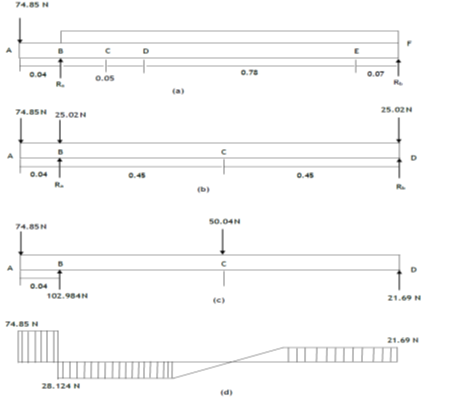
Determination of power required to drive the pulley and shaft
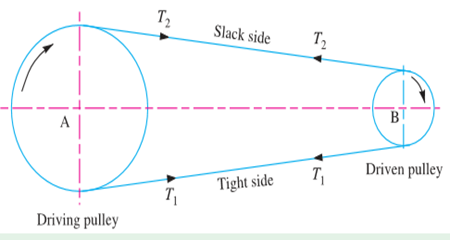
Let
T1 = Tensions in the tight side of the belt
T2 = Tensions in the slack side of the belt in Newton’s,
r1 = radii of the driving pulley
r2 = radii of the driven pulleys in meters,
ν = velocity of the belt in m/s.
The efficient rotational force at the circumference of the driven pulley is the difference between the two tensions, T1 and T2).
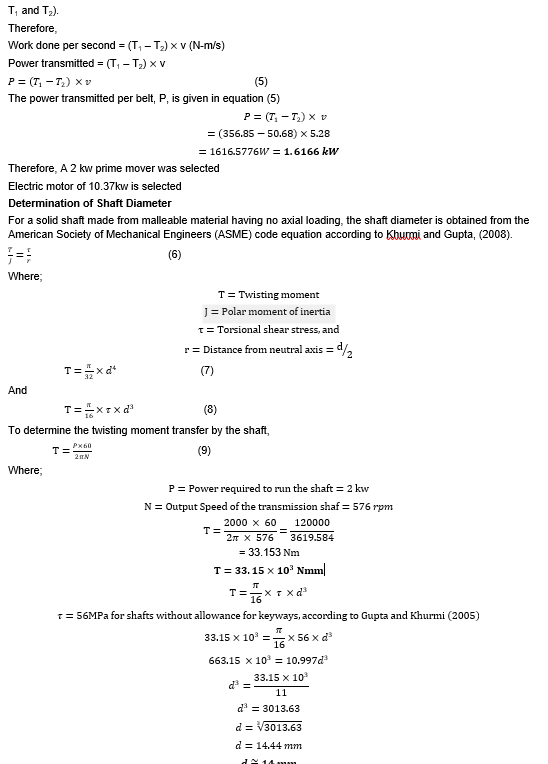
Therefore, a shaft of 14 mm was selected.
Belt design and selection
Since it is a 3-way pulley system, the conventional belt calculation formula will not be applicable. Equations according to William, (1953) will be considered to resolve the calculation for the belt length.
From Figure 4,
AD = Pulley A diameter,
BD = Pulley B, diameter
CD = Pulley C, diameter
a is the center distance between of pulley B and C
b is the center distance between of pulley C and A
c is the center distance between of pulley A and B
Total length of belt = L
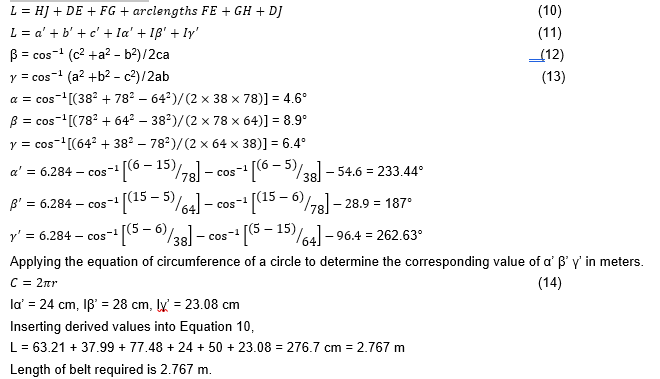
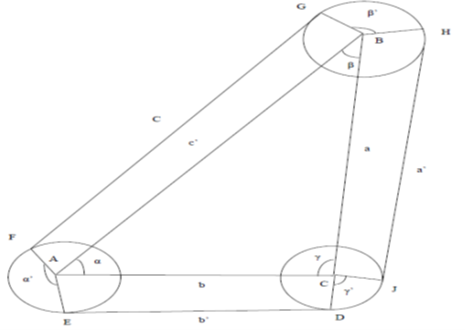
Principle of Operation
The domestic rice de-stoning machine developed is made up of the reservoir, de-stoning chamber, washing chamber, and outlet. The de-stoning chamber is made up of the hopper and impeller blade, it is supported with the aid of a frame. The washing chamber unit which consist of a brush drum is position parallel to the de-stoning chamber unit.
The machine was switch on and allowed to run at no load to ascertain its condition. The sample prepared which contains 2kg of rice grain mixed with 20 pieces stone of different sizes was fed through the hopper to the de-stoning chamber, which happens to be 1/3 of the volume of de-stoning chamber, water was displaced from a reservoir tank to the de-stoning chamber. Variable speed electric motor with speed rating from 1400rpm to 10rpm was used which provide the motion of the shafts and rotate the impeller blade to stir the infested rice at a considerable speed and at given time. As a result of bulk density difference of stone/sand which is 1.33g/cm3 (irregular in shape) while 0.51g/cm3 for rice large quantity of rice float into the washing chamber for proper cleaning with the aid of brush drum and be collected at the rice outlet, while the stones settled down at the bottom of the de-stoning chamber and be collected at the coarse surface. The water pass through a screen and be re-circulated to the reservoir to avoid water wastage.

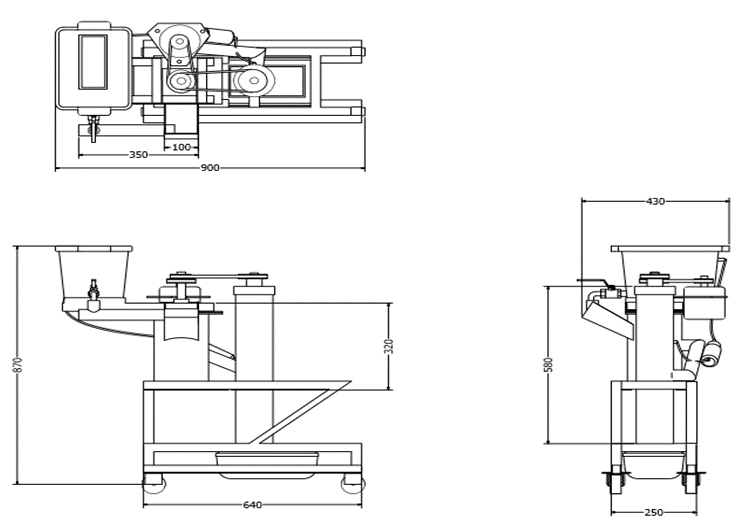
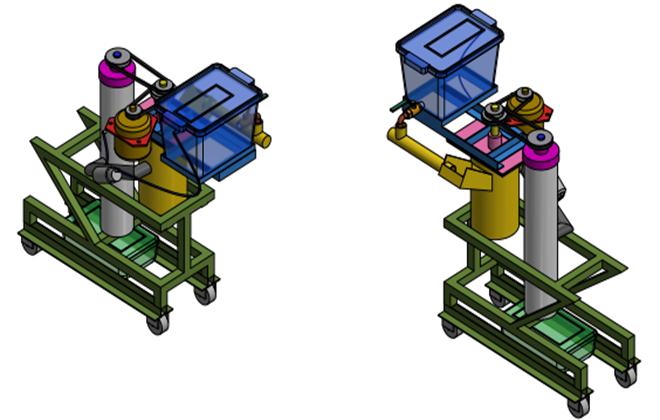
Test, Result and Discussion
- Test
- Result of test analysis on rice de-stoning machine
In order to actualize the aims of this study the rice de-stoning machine using wet medium was tested and fabricated to evaluate its performance. In each run base on the experiments, 2 kilogram of rice and 20 pieces of stones of different sizes was used. The de-stoning was carried out at variable speed of 1400 rpm - 10 rpm. A variable electric motor was chosen to determine the functioning of the developed machine at a constant time of 10 minutes. The machine was run without load using a single phase, 1440 and a 1.8 kW petrol engine whereas the shaft was run at a speed of 10 rpm.
The separation effectiveness of the rice and stone obtained at different speeds are presented in Table 2,
Table 2: Machine Performance Evaluation
SPEED (RPM) | RICE (g) | NO. OF STONES | RICE IN WASHING CHAMBER (g) | STONE IN WASHING CHAMBER | RICE IN DE-STONING CHAMBER (g) | STONE IN THE DE-STONING CHAMBER |
1400 | 2000 | 20 | 2000 | 20 | 0 | 0 |
1200 | 2000 | 20 | 1950 | 17 | 50 | 3 |
1000 | 2000 | 20 | 1940 | 15 | 60 | 5 |
800 | 2000 | 20 | 1935 | 10 | 65 | 10 |
600 | 2000 | 20 | 1930 | 4 | 70 | 16 |
400 | 2000 | 20 | 1928 | 0 | 72 | 20 |
200 | 2000 | 20 | 1800 | 1 | 200 | 19 |
100 | 2000 | 20 | 1500 | 2 | 500 | 18 |
50 | 2000 | 20 | 750 | 0 | 1250 | 16 |
30 | 2000 | 20 | 300 | 0 | 1700 | 20 |
20 | 2000 | 20 | 0 | 0 | 2000 | 20 |
10 | 2000 | 20 | 0 | 0 | 2000 | 20 |
Discussion of Results
Results from experimental investigations carried out under the workshop conditions are discussed. The effect of different operational parameters like percentage of stone separation, rice cleaning efficiency and de-stoning machine are presented and discussed.
- Percentage of stone separation
The results of test analysis on the rice de-stoning machine using wet medium confirms that, at a very high speed of 1400rpm both the rice and the stone flow together as a result of high torque and there was no separation of stone from the rice. At a speed of 1200rpm, 3 pieces of stone were recovered whereas the remaining flow with the rice to the washing chamber which gives only 15% of stone removed. At 1000rpm, 800rpm, 600rpm, and 400rpm gives 25%, 50%, 80% and 100% stone removal.
At a very low speed of 200rpm and 100rpm gives 5% and 10% stone removal while at 50rpm, 30rpm, 20rpm and 10rpm gives 0% as there was no de-stoning of stone as a result of very low torque, it settled at the coarse surface of the de-stoning chamber and was collected through the stone outlet. This shows that the speed of 400 rpm is the best speed for the stone removal from the rice.
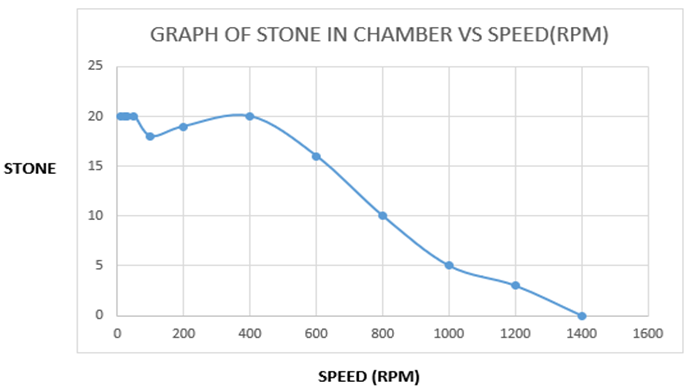
- Rice Cleaning Efficiency
The cleaning effectiveness of the machine increase as a result of resultant increase in speed of the impeller blade. Evaluation result as seen in Figure 8 revealed that cleaning efficiency recorded for machine at a very high speed of 1400rpm, there was no rice destoning as both the rice and stone flow together to the washing chamber as a result of high torque. At 1200rpm, 1000rpm, 800rpm and 600rpm which gives 97.5%, 97%, 96.75% and 96.5% of the rice that flow to the washing chamber but still contains stones which make it not favorable but at 400rpm gives 96.4% of the clean rice separated without a stone.
At a very low speed of 200rpm and 100rpm gives 90%, 75% but contain some pieces of stone, at 50rpm and 30rpm gives 37.5% and 15% only small quantity of rice without stones was separated while at 20rpm and 10rpm there was no de-stoning of rice and stone as a result of very low torque both the rice and stone settled at the bottom of the de-stoning chamber.
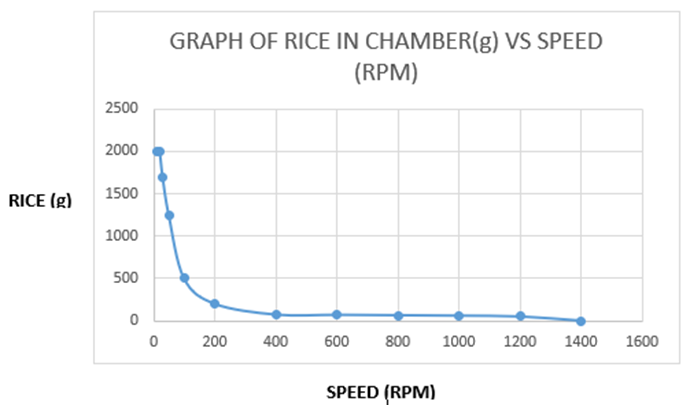
Conclusion
The performance on developing and testing a rice de-stoning machine that uses wet medium and works with one type and the same amount of rice was accomplished. The equipment performed admirably in tests, according to the results. The following are some of the work's particular conclusions:
The machine's stone separation rose as the impeller's speed grew, and decreased as the impeller's speed decreased. Rice separation rises with increasing speed and reduces with decreasing speed, with no rice loss or breaking. After separation, the impurity was extensively cleaned in the washing chamber. For simplicity of maintenance, the domestic rice de-stoning machine may be simply manufactured with locally accessible components. The Federal Government of Nigeria may encourage domestic, medium, and small-scale enterprises to create clean rice from domestically grown rice that contains sand/stones and other impurities, lowering unemployment and our reliance on rice imports in Nigeria.
With these findings, more work will be done to increase the machine's overall performance indices, such as stone separation, rice separation, and rice retention efficiency.
Following the testing of the machine, it was ascertained to efficiently de-stone several varieties of locally process rice.
Acknowledgement
The authors acknowledge moral support from the Engineering Materials Development Institute, Akure (EMDI) and The Federal University of Technology, Akure (FUTA).
References
- Adegun, I. K., Adepoju, S. A., & Aweda, J. A. (2012). A mini rice processing machine for Nigerian farmers. Journal of Agricultural Technology, 8(4), 1207-1216.
- Adejuyigbe, S. B., & Bolaji, B. O. (2005). Design, fabrication and performance evaluation of beans dehuller. Journal of Science and Technology (Ghana), 25(1), 125-132.
- Adejuyigbe, S. B. and Bolaji. B. O. (2012). “Development and Performance Evaluation of A Rice Destoning Machine Using Vibrating Sieves’’, Journal of Natural Science, Engineering and Technology Agricultural Mechanization in Asia, Africa and Latin America. 2012, 11(2): 94-105 ISSN: 2277 – 0593
- Adetola, O. A., & Akindahunsi, D. L. (2020). A review on performance of rice de-stoning machines. Journal of Engineering Research and Reports, 13(1), 1-11.
- Agidi, G. Ndagi, B. Kuku, A.M. and Abdullahi L. (2015). Development and testing of a rice destoning machine. International Journal Engineering. Resources & Science & Technology. 2015;4 (3). ISSN: 2319-5991
- Bhagirath S.C. Khawar J. Gulshan M. Text book on Rice Production Worldwide, Spring International Publishing AG 2017.
- Erhie, E. et al. (2018) Boosting rice production through increased mechanisation. Lagos.
- Eric, O., Franklin, D.J. and Holbrook. L.H. (1982), Machinery handbook, 21st edition, industrial press Inc., New York. pp 24-26.
- Fadeyibi A, Osunde Z. D, Ussaini M. S, Idah P. A, Balami A. A. Evaluating monolayer moisture content of rubber seed using BET and GAB sorption equations. International Journal of Farming and Allied Sciences. 2012;1 (3):72-76.
- Food and Agricultural Organisation (FAO). (2011). Food and Agriculture Organization Statistical Data Base, Rome. Available at: http.fao.org/. Accessed 7 January 2013.
- Food and Agriculture Organization (FAO 2010)
- Henderson S. M, Perry R. L. Agricultural process engineering, 3rd Edition. The Avi Publishing Company, Incorporated, West – Port, Connecticut. 1976; 170–189
- Iyobosa, O. I. (2020). Design and Construction of an Electrically Operated Paint Mixing Machine. Journal of Engineering Research and Reports, 14(3), 20-29.
- International Rice Research Institute (IRRI). (2010). World Rice Statistics. Available at: http://beta.irri.org/solutions/index.php. Accessed 6 December 2017
- Khurmi, R. S. and Gupter, J. K. Machine Design, 14th Edition. New Delhi: Eurasia (PVT) Ltd, 2005, p. 1230, 509-557, 677-714, 725-758.
- Masser M.P. and Jensen J.W. (1991). Calculating area and volume of ponds and tanks SRAC Publication No. 103 pp 1-8
- Mohammed D. T. Introduction of Faro-52 (WITA-4) Rice variety as a measure of solving low yield problem among farmers in Yola-north local government area of Adamawa State, Nigeria. International Journal of Innovative Agriculture and Biology Research. 2016;4 (2):1–7.
- Mohammed, G. A. N. A., Fadeyibi, A., Katibi, K. K., & Ucheoma, O. C. (2017). Performance evaluation and modification of an existing rice destoner. International Journal of Engineering Technologies IJET, 3(3), 169-175.
- Nathan W. and Bonnie LeBeau (2022), Rice outlook: April 2022, RSC-22C, April 12, 2022 USDA, Economic Research Service
- Ogunlowo A. S, Adesuyi S. A. A low-cost rice cleaning and de-stoning machine. Agricultural Mechanization in Asia, Africa and Latin America. 1999;30 (1):20-24
- Ogunlowo A. S, Adesuyi S. A. A low-cost rice cleaning/de-stoning machine. European Centre for Research Training and Development UK. 2014;2 (2):33-43
- Ogunlowo, A. S. and Adesuyi, A. S. (2019). “A Low-cost rice cleaning/destoning machine’’, Published by European Centre for Research Training and Development UK. 2014; 2(2); 33-43
- Ojediran, J. O., Clinton Emeka, O., Afolabi, O. A., & Samuel, A. A. (2018). Development of a motorized rice de-stoning machine. Agricultural Engineering International: CIGR Journal, 20(4).
- Okunola, A. A., Igbeka, J. C., & Arisoyin, A. G. (2015). Development and evaluation of a cereal cleaner. Journal of Multidisciplinary Engineerring Science and Technology, 2(6), 1587-1592.
- Oludare, A. O. (2014) ‘Analysis of the efficiency of mechanized and non-mechanized rice production in Kaduna State, Nigeria’.
- Seck, P. A., Diagne, A., Mohanty, S., & Wopereis, M. C. (2012). Crops that feed the world 7: Rice. Food security, 4, 7-24.
- Simonyan K. S, Emordi I. S, Adama J. C. Development of a locally designed rice destoning machine. Journal of Agricultural Engineering and Technology (JAET). 2010;18(2).
- Terwase, I. T., & Madu, A. Y. (2014). The impact of rice production, consumption and importation in Nigeria: the political economy perspectives. International Journal of Sustainable Development & World Policy, 3(4), 90.
- United States Department of Agriculture (USDA) and Foreign Agricultural Services FAS 2010).
- Usman, M. Balogun, A. L. and Oyebanre, O. D. (2018). Design, fabrication and testing of a rice destoning machine. International Conference of Science, Engineering and Technology. 2018;3(1):1-12.
- Von, B. and Kole, C. (2006) ‘Cereals and Millets schnell und portofrei erhältlich bei’. Available at: http://www.beckshop.de/fachbuch/leseprobe/9783540340317_Excerpt_001.pdf
- William, L.A. (1953). Mechanical Power Transmission Manual Conover - Mast Publ. New York. NY, USA. pp 165-174.
Quick linksss
- Abstract
- Introduction
- Previous Studies
- Methodology
- Machine Design Calculation
- Hopper Capacity
- Capacity of the De-Stoning Unit
- Shaft Design
- Shaft design
- Determination of power required to drive the pulley and shaft
- Principle of Operation
- Test, Result and Discussion
- Discussion of Results
- Conclusion
- Acknowledgement
- References


